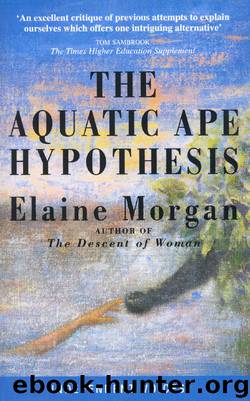The Aquatic Ape Hypothesis by Elaine Morgan

Author:Elaine Morgan
Language: eng
Format: epub
ISBN: 9780285639812
Publisher: Souvenir Press
Published: 2011-04-10T16:00:00+00:00
Alternative theories
Darwin tried hard to find a reason why we differ from the apes in this respect. He focused on the greater variety and complexity of muscles which make human faces so much more richly expressive than animal ones. He suggested that ‘… whenever the muscles round the eyes are strongly and involuntarily contracted in order to compress the blood vessels and thus to protect the eyes… ’ (during, for example, a screaming fit in a young child) ‘tears are secreted, often in sufficient abundance to roll down the cheeks’.13 In support of this, he noticed that when the orbicular muscles are contracted for other reasons, such as violent coughing or vomiting, tears are often shed.
But tears are often shed silently and with no muscular contractions. And Darwin himself noted that young infants may scream violently with their eyes tightly closed, yet no tears are shed because the lachrymal glands have not ‘come to full functional activity’. However, that last statement needs qualifying. It is only the shedding of non-reflex tearing that has not begun to function. When he accidentally touched the eyeball of one of his infant children with the sleeve of his coat, the reflex tears flowed quite freely.14 He offered no reason why the muscular contractions around the eyes did not cause the shedding of tears as readily as the touch of a coat sleeve.
Ashley Montagu in 1959 proposed that the shedding of tears was a protection against damage to the mucous membranes of the nose caused by ‘dry crying’, because screaming and sobbing involve excessive intake and expulsion of the breath which dries up the membranes.15 He argued that in early man ‘those individuals were naturally selected in the struggle for existence who were able to produce an abundant flow of tears since the tears acted as a preventative of mucosal dehydration’, and he explains the differences between men and apes by referring to the longer dependency of human infants.
The weakness of this theory is that while young apes do not remain physically as helpless as human babies over such a long period, they do continue to indulge in prolonged noisy tantrums and what he calls ‘tearless crying’ right up to the time they are weaned. Also the deleterious effects of dry crying which he lists affect the nasal passages alone. Screaming and breathing in and out do not dehydrate the eyeballs. To cope with these problems natural selection would have favoured insulatory secretions in the nasal passages themselves—as in colds and catarrh—rather than the shedding of saline fluid from the lachrymal glands, most of which flows uselessly away.
E. Treacher Collins (1932) suggested that weeping ‘has arisen in human infants as a purposive action to attract attention with the object of eliciting aid and sympathy’.16 It may often be resorted to with that object, but it can hardly have evolved for that purpose. A human baby, like its anthropoid cousins, is very good at attracting attention. It can open its mouth into a wide square-shaped hole, distort its features, go red in the face, and utter ear-splitting and heart-rending noises.
Download
This site does not store any files on its server. We only index and link to content provided by other sites. Please contact the content providers to delete copyright contents if any and email us, we'll remove relevant links or contents immediately.
Sapiens: A Brief History of Humankind by Yuval Noah Harari(14320)
Sapiens by Yuval Noah Harari(5322)
Pale Blue Dot by Carl Sagan(4953)
Homo Deus: A Brief History of Tomorrow by Yuval Noah Harari(4871)
Livewired by David Eagleman(3729)
Origin Story: A Big History of Everything by David Christian(3666)
Brief Answers to the Big Questions by Stephen Hawking(3393)
Inferior by Angela Saini(3293)
Origin Story by David Christian(3170)
Signature in the Cell: DNA and the Evidence for Intelligent Design by Stephen C. Meyer(3098)
The Gene: An Intimate History by Siddhartha Mukherjee(3074)
The Evolution of Beauty by Richard O. Prum(2963)
Aliens by Jim Al-Khalili(2803)
How The Mind Works by Steven Pinker(2777)
A Short History of Nearly Everything by Bryson Bill(2659)
Sex at Dawn: The Prehistoric Origins of Modern Sexuality by Ryan Christopher(2500)
From Bacteria to Bach and Back by Daniel C. Dennett(2462)
Endless Forms Most Beautiful by Sean B. Carroll(2443)
Who We Are and How We Got Here by David Reich(2417)
